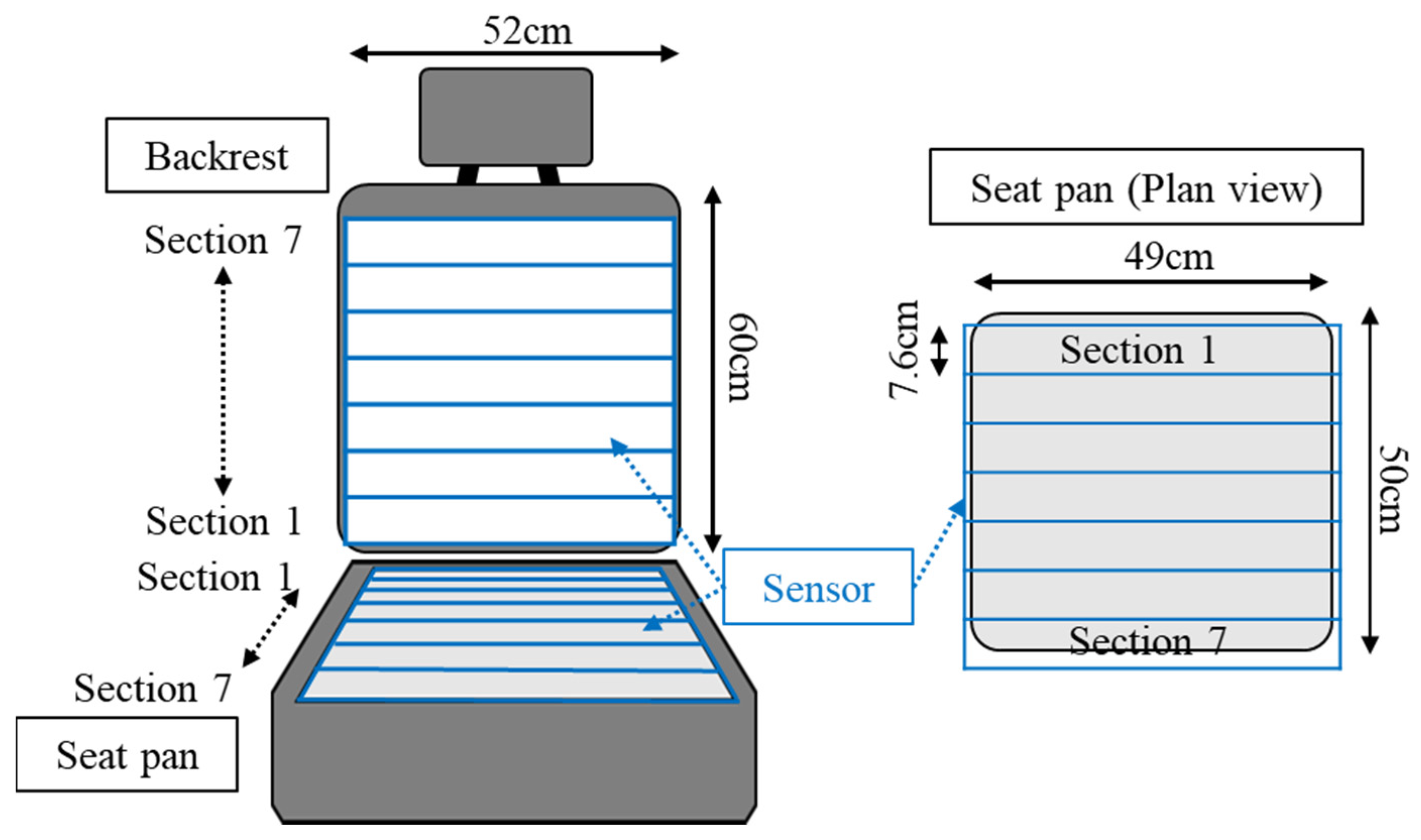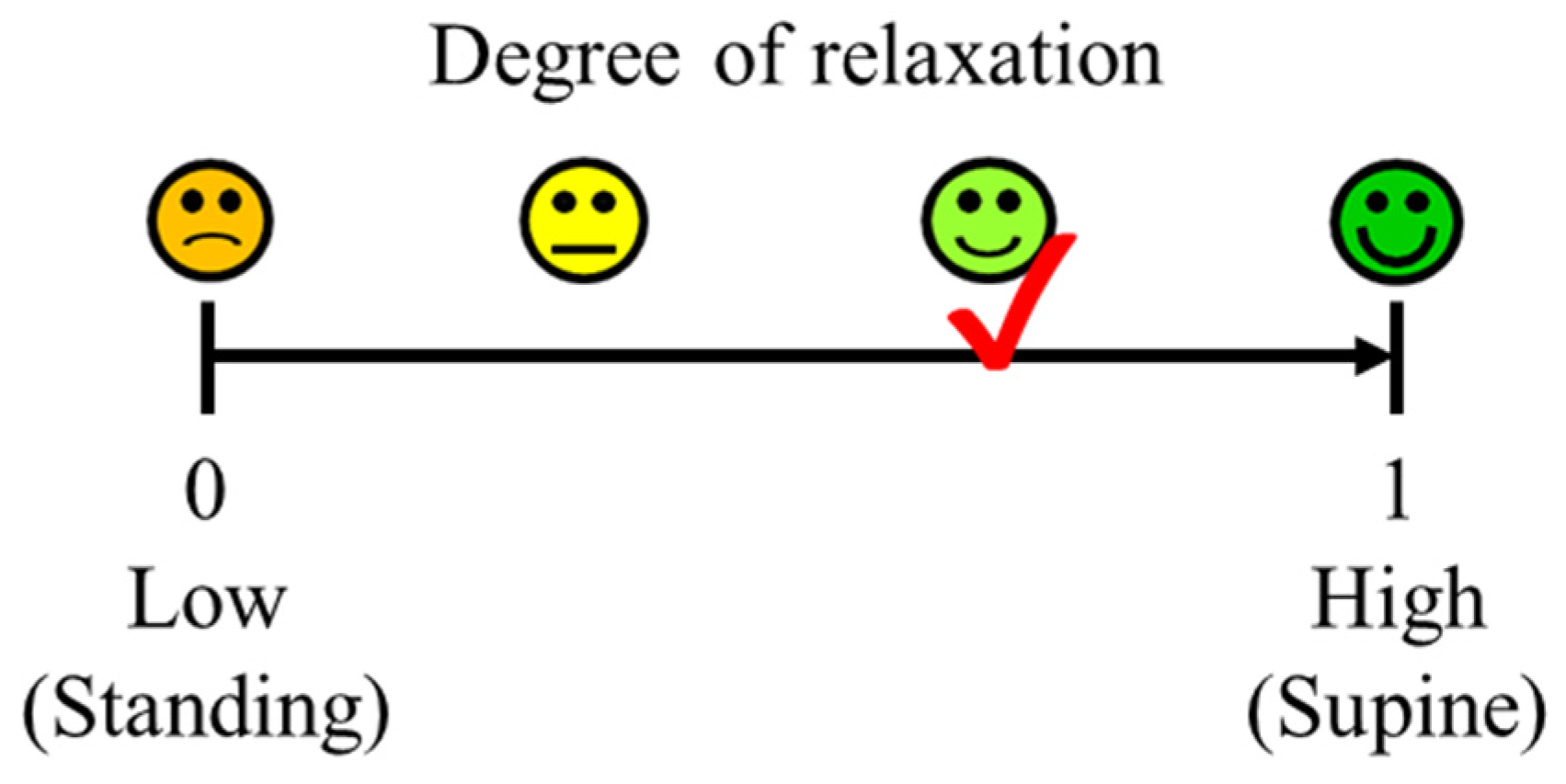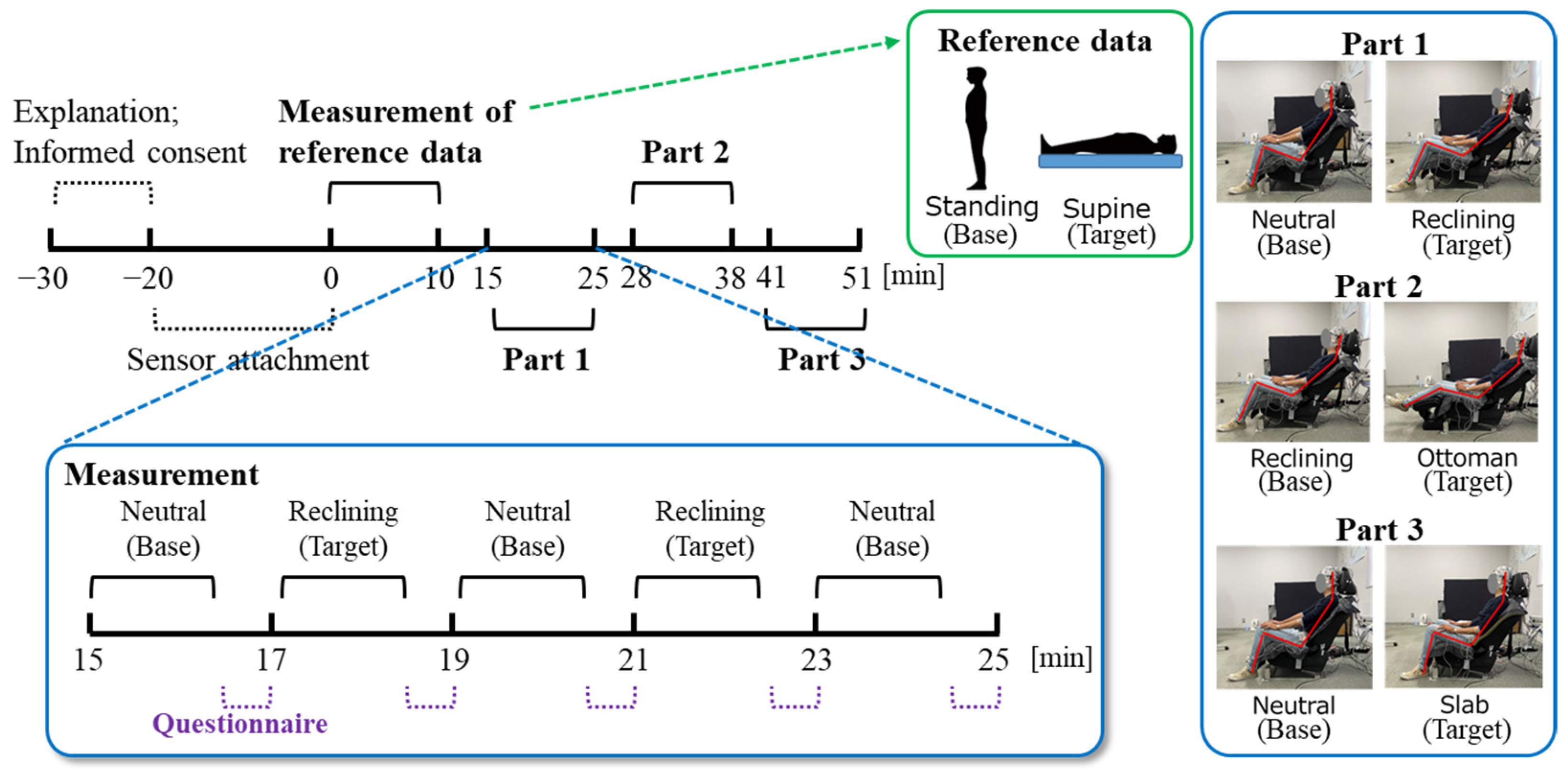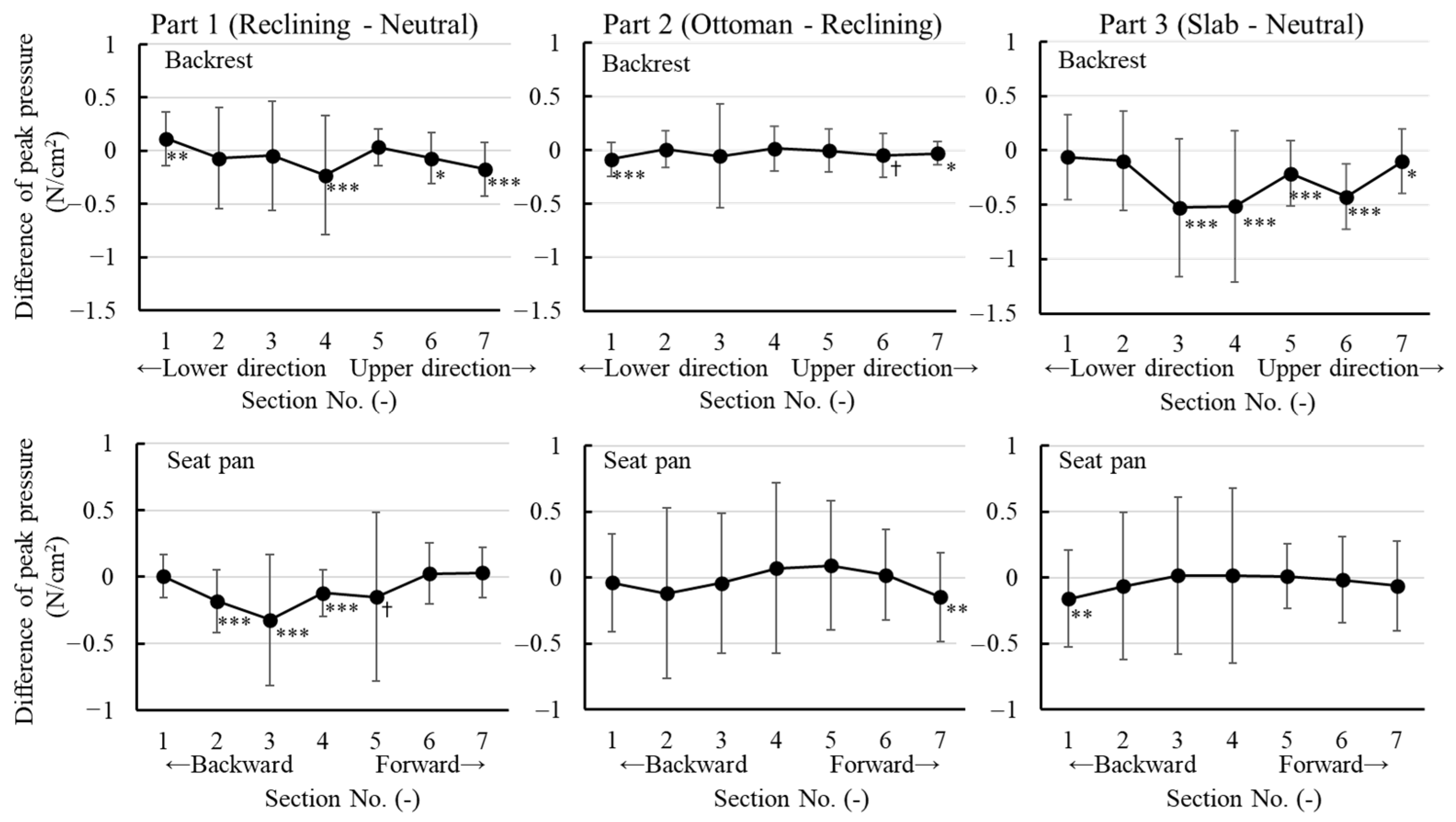Physiological Responses Related to Sitting Comfort Due to Changes in Seat Parameters
Abstract
:1. Introduction
2. Materials and Methods
2.1. Participants
2.2. Seat Conditions
2.3. Measurement
2.3.1. Musculoskeletal States
2.3.2. Physiological States
2.3.3. Questionnaire for Relaxation
2.4. Experimental Procedure
2.5. Data Analysis
3. Results
3.1. Spine Posture
3.2. Pressure Variables
3.3. Subjective Evaluation for Relaxation
3.4. Physiological Responses
4. Discussion
5. Conclusions
Author Contributions
Funding
Institutional Review Board Statement
Informed Consent Statement
Data Availability Statement
Conflicts of Interest
References
- Crundall, D.E.; Underwood, G. Effects of experience and processing demands on visual information acquisition in drivers. Ergonomics 1998, 41, 448–458. [Google Scholar] [CrossRef]
- Nahvi, H.; Fouladi, M.H.; Nor, M.J.M. Evaluation of whole-body vibration and ride comfort in a passenger car. Int. J. Acoust. Vib. 2009, 14, 143–149. [Google Scholar] [CrossRef]
- Gwak, J.; Yoshinami, Y.; Hirao, A.; Shino, M. Repeated Thermal Stimulation by Cabin Temperature for Keeping Arousal and Thermal Comfort of Driver. Int. J. Automot. Eng. 2022, 13, 83–88. [Google Scholar] [CrossRef]
- Zhang, L.; Helander, M.G.; Drury, C.G. Identifying Factors of Comfort and Discomfort in Sitting. Hum. Factors 1996, 38, 377–389. [Google Scholar] [CrossRef]
- De Looze, M.P.; Kuijt-Evers, L.F.M.; Van Dieën, J.H. Sitting Comfort and Discomfort and the Relationships with Objective Measures. Ergonomics 2003, 46, 985–997. [Google Scholar] [CrossRef] [PubMed]
- Hiemstra-van Mastrigt, S.; Groenesteijn, L.; Vink, P.; Kuijt-Evers, L.F.M. Predicting passenger seat comfort and discomfort on the basis of human, context and seat characteristics: A literature review. Ergonomics 2017, 60, 889–911. [Google Scholar] [CrossRef] [PubMed]
- Vincent, A.; Bhise, V.D.; Mallick, P. Seat Comfort as a Function of Occupant Characteristics and Pressure Measurements at the Occupant-Seat Interface; SAE Technical Paper; SAE International: Warrendale, PA, USA, 2012; pp. 1–18. [Google Scholar] [CrossRef]
- Ciaccia, F.; Sznelwar, L. An Approach to Aircraft Seat Comfort Using Interface Pressure Mapping. Work 2012, 41, 240–245. [Google Scholar] [CrossRef]
- Greve, J.M.; Cuğ, M.; Dülgeroğlu, D.; Brech, G.C.; Alonso, A.C. Relationship between anthropometric factors, gender, and balance under unstable conditions in young adults. BioMed Res Int. 2013, 2013, 850424. [Google Scholar] [CrossRef]
- Park, J.; Choi, Y.; Lee, B.; Sah, S.; Jung, K.; You, H. Sitting Strategy Analysis based on Driving Postures and Seating Pressure Distributions. Proc. Hum. Factors Ergon. Soc. Annu. Meet. 2013, 57, 1983–1986. [Google Scholar] [CrossRef]
- Kyung, G.; Nussbaum, M.A. Age-related Difference in Perceptual Responses and Interface pressure Requirements for Driver Seat Design. Ergonomics 2013, 56, 1795–1805. [Google Scholar] [CrossRef]
- Moes, C.C.M. Variation in Sitting Pressure Distribution and Location of the Points of Maximum Pressure with Rotation of the Pelvis, Gender and Body Characteristics. Ergonomics 2007, 50, 536–561. [Google Scholar] [CrossRef]
- Paul, G.; Daniell, N.; Fraysse, F. Patterns of Correlation between Vehicle Occupant Seat Pressure and Anthropometry. Work 2012, 41, 2226–2231. [Google Scholar] [CrossRef] [PubMed]
- Kyung, G.; Nussbaum, M.A. Driver Sitting Comfort and Discomfort (Part II): Relationships with and Prediction from Interface Pressure. Int. J. Ind. Ergon. 2008, 38, 526–538. [Google Scholar] [CrossRef]
- Fasulo, L.; Naddeo, A.; Cappetti, N. A study of classroom seat (dis)comfort: Relationships between body movements, center of pressure on the seat, and lower limbs’ sensations. Appl. Ergon. 2019, 74, 233–240. [Google Scholar] [CrossRef] [PubMed]
- Carcone, S.M.; Keir, J.K. Effects of Backrest Design on Biomechanics and Comfort during Seated Work. Appl. Ergon. 2007, 38, 755–764. [Google Scholar] [CrossRef]
- De Carvalho, D.E.; Callaghan, J.P. Spine Posture and Discomfort during Prolonged Simulated Driving With Self-Selected Lumbar Support Prominence. Hum. Factors 2015, 57, 976–987. [Google Scholar] [CrossRef]
- Giannakakis, G.; Grigoriadis, D.; Giannakaki, K.; Simantiraki, O.; Roniotis, A.; Tsiknakis, M. Review on psychological stress detection using biosignals. IEEE Trans. Affect. Comput. 2019, 13, 440–460. [Google Scholar] [CrossRef]
- Gwak, J.; Yoshitake, H.; Shino, M. Effects of visual factors during automated driving of mobility scooters on user comfort: An exploratory simulator study. Transp. Res. Part F Psychol. Behav. 2021, 81, 608–621. [Google Scholar] [CrossRef]
- Gyi, D.E.; Porter, J.M. Interface pressure and the prediction of car seat discomfort. Appl. Ergon. 1999, 30, 99–107. [Google Scholar] [CrossRef]
- Kolich, M.; Taboun, S.M. Ergonomics modelling and evaluation of automobile seat comfort. Ergonomics 2007, 841–863. [Google Scholar] [CrossRef]
- Hirao, A.; Kato, K.; Kitazaki, S.; Yamazaki, N. Qualitative and Quantitative Evaluations of Physical Fatigue during Long-term Driving. J. JSAE 2008, 39, 153–158. [Google Scholar] [CrossRef]
- Sharbrough, F.; Chatrian, G.E.; Lesser, R.P.; Luders, H.; Nuwer, M.; Picton, T.W. American Electroencephalographic Society guidelines for standard electrode position nomenclature. J. Clin. Neurophysiol. 1991, 8, 200–202. [Google Scholar]
- Coburn, K.L.; Moreno, M.A. Facts and artifacts in brain electrical activity mapping. Brain Topogr. 1988, 1, 37–45. [Google Scholar] [CrossRef] [PubMed]
- Fatourechi, M.; Bashashati, A.; Ward, R.K.; Birch, G.E. EMG and EOG artifacts in brain computer interface systems: A survey. Clin. Neurophysiol. 2007, 118, 480–494. [Google Scholar] [CrossRef] [PubMed]
- Delorme, A.; Makeig, S. EEGLAB: An open source toolbox for analysis of single-trial EEG dynamics including independent component analysis. J. Neurosci. Methods 2004, 134, 9–21. [Google Scholar] [CrossRef]
- Brookhuis, K.A.; De Waard, D. The use of psychophysiology to assess driver status. Ergonomics 1993, 39, 1099–1110. [Google Scholar] [CrossRef]
- Eoh, H.J.; Chung, M.K.; Kim, S.H. Electroencephalographic study of drowsiness in simulated driving with sleep deprivation. Int. J. Ind. Ergon. 2005, 35, 307–320. [Google Scholar] [CrossRef]
- Deits-Lebehn, C.; Smith, T.W.; Williams, P.G.; Uchino, B.N. Heart rate variability during social interaction: Effects of valence and emotion regulation. Int. J. Psychophysiol. 2023, 190, 20–29. [Google Scholar] [CrossRef]
- Aissaoui, R.; Lacoste, M.; Dansereau, J. Analysis of sliding and pressure distribution during a repositioning of persons in a simulator chair. IEEE Trans. Neural Syst. Rehabil. Eng. 2001, 9, 215–224. [Google Scholar] [CrossRef]
- Gazzaniga, M.S.; Ivry, R.B.; Mangun, G.R. Cognitive Neuroscience: The Biology of the Mind, 3rd ed.; W. W. Norton & Company: New York, NY, USA, 2009; pp. 71–77. [Google Scholar]
- Brodoehl, S.; Klingner, C.; Stieglitz, K.; Witte, O.W. Age-related changes in the somatosensory processing of tactile stimulation—An fMRI study. Behav. Brain Res. 2013, 238, 259–264. [Google Scholar] [CrossRef]
- Radhakrishna, R.K.; Dutt, D.N.; Yeragani, V.K. Nonlinear measures of heart rate time series: Influence of posture and controlled breathing. Auton. Neurosci. 2000, 83, 148–158. [Google Scholar] [CrossRef] [PubMed]
- Siebert, J.; Drabik, P.; Lango, R.; Szyndler, K. Stroke volume variability and heart rate power spectrum in relation to posture changes in healthy subjects. Med. Sci. Monit. 2004, 10, MT31–MT37. [Google Scholar] [PubMed]
- Rahman, J.S.; Gedeon, T.; Caldwell, S.; Jones, R. Brain Melody Informatics: Analysing Effects of Music on Brainwave Patterns. In Proceedings of the International Joint Conference on Neural Networks (IJCNN), Glasgow, UK, 19–24 July 2020; pp. 1–8. [Google Scholar] [CrossRef]
- Hima, C.S.; Asheeta, A.; Chithra, C.N.; Sandhya, M.J.N.; Fathima, B.U. A Review on Brainwave Therapy. World J. Pharm. Sci. 2020, 8, 59–66. Available online: https://wjpsonline.com/index.php/wjps/article/view/review-brainwave-therapy (accessed on 30 July 2024).
- Grossman, P.; Svebak, S. Respiratory sinus arrhythmia as an index of parasympathetic cardiac control during active coping. Int. J. Psychol. 1987, 24, 228–235. [Google Scholar] [CrossRef] [PubMed]
- Ruediger, H.; Seibt, R.; Scheuch, K.; Krause, M.; Alam, S. Sympathetic and parasympathetic activation in heart rate variability in male hypertensive patients under mental stress. J. Hum. Hypertens. 2004, 18, 307–315. [Google Scholar] [CrossRef]









| Neutral | Reclining | Ottoman | Slab | |
|---|---|---|---|---|
| Neck-horizontal angle (deg.) | 84.8 (3.1) | 71.6 (3.3) | 69.6 (3.7) | 81.6 (3.7) |
| Torso angle (deg.) | 36.7 (3.6) | 48.0 (2.8) | 51.0 (3.6) | 36.0 (4.0) |
| Hip angle (deg.) | 112.1 (4.8) | 124.0 (5.6) | 126.7 (6.0) | 109.8 (5.5) |
| Knee angle (deg.) | 97.1 (14.5) | 98.3 (15.3) | 141.2 (4.9) | 91.7 (14.8) |
| Foot-horizontal angle (deg.) | 68.3 (12.1) | 67.8 (11.2) | 24.4 (3.8) | 72.1 (11.0) |
| Index | Reference (Supine-Standing) | Part 1 (Reclining-Neutral) | ||||
| Mean of Difference (SD) | t | p-Value | Mean of Difference (SD) | t | p-Value | |
| (θ + α)/β of Cz | −0.04 (0.47) | −0.61 | 0.547 | 0.11 (0.85) | 0.98 | 0.331 |
| (θ + α)/β of C3 | 0.27 (0.53) | 3.37 | 0.002 | 0.10 (0.49) | 1.53 | 0.131 |
| (θ + α)/β of C4 | 0.15 (0.51) | 2.03 | 0.048 | 0.00 (0.79) | 0.02 | 0.983 |
| (θ + α)/β of Pz | 0.34 (1.24) | 1.82 | 0.075 | 0.01 (0.90) | 0.11 | 0.916 |
| (θ + α)/β of P3 | 0.51 (1.40) | 2.44 | 0.019 | 0.03 (1.03) | 0.19 | 0.851 |
| (θ + α)/β of P4 | 0.38 (1.59) | 1.61 | 0.114 | −0.03 (0.89) | −0.26 | 0.797 |
| RRI (ms) | 186 (94) | 13.21 | <0.001 | 13 (27) | 3.93 | <0.001 |
| LF/HF | −2.26 (2.89) | −5.25 | <0.001 | −0.03 (1.25) | −0.18 | 0.862 |
| HF content | 0.36 (0.22) | 10.80 | <0.001 | −0.01 (0.18) | −0.55 | 0.583 |
| Respiration rates (Hz) | −0.005 (0.042) | −0.86 | 0.393 | −0.009 (0.026) | −2.51 | 0.015 |
| Index | Part 2 (Ottoman-Reclining) | Part 3 (Slab-Neutral) | ||||
| Mean of Difference (SD) | t | p-Value | Mean of Difference (SD) | t | p-Value | |
| (θ + α)/β of Cz | −0.19 (0.63) | −2.29 | 0.026 | 0.11 (0.45) | 1.89 | 0.063 |
| (θ + α)/β of C3 | −0.02 (0.46) | −0.30 | 0.762 | −0.01 (0.60) | −0.07 | 0.947 |
| (θ + α)/β of C4 | −0.15 (0.43) | −2.63 | 0.011 | 0.12 (0.63) | 1.44 | 0.155 |
| (θ + α)/β of Pz | −0.24 (1.04) | −1.77 | 0.081 | 0.29 (1.12) | 1.83 | 0.072 |
| (θ + α)/β of P3 | −0.16 (0.96) | −1.28 | 0.204 | 0.13 (1.10) | 0.90 | 0.374 |
| (θ + α)/β of P4 | −0.19 (1.00) | −1.50 | 0.140 | 0.27 (1.12) | 1.90 | 0.062 |
| RRI (ms) | 21 (33) | 4.96 | <0.001 | 0 (29) | 0.06 | 0.953 |
| LF/HF | −0.36 (1.17) | −2.22 | 0.030 | −0.09 (1.51) | −0.46 | 0.646 |
| HF content | 0.07 (0.20) | 2.63 | 0.011 | 0.03 (0.20) | 1.29 | 0.202 |
| Respiration rates (Hz) | 0.007 (0.028) | 1.80 | 0.078 | 0.005 (0.028) | 1.48 | 0.145 |
Disclaimer/Publisher’s Note: The statements, opinions and data contained in all publications are solely those of the individual author(s) and contributor(s) and not of MDPI and/or the editor(s). MDPI and/or the editor(s) disclaim responsibility for any injury to people or property resulting from any ideas, methods, instructions or products referred to in the content. |
© 2024 by the authors. Licensee MDPI, Basel, Switzerland. This article is an open access article distributed under the terms and conditions of the Creative Commons Attribution (CC BY) license (https://creativecommons.org/licenses/by/4.0/).
Share and Cite
Gwak, J.; Arata, K.; Yamakawa, T.; Tobata, H.; Shino, M.; Suda, Y. Physiological Responses Related to Sitting Comfort Due to Changes in Seat Parameters. Appl. Sci. 2024, 14, 7870. https://doi.org/10.3390/app14177870
Gwak J, Arata K, Yamakawa T, Tobata H, Shino M, Suda Y. Physiological Responses Related to Sitting Comfort Due to Changes in Seat Parameters. Applied Sciences. 2024; 14(17):7870. https://doi.org/10.3390/app14177870
Chicago/Turabian StyleGwak, Jongseong, Kazuyoshi Arata, Takumi Yamakawa, Hideo Tobata, Motoki Shino, and Yoshihiro Suda. 2024. "Physiological Responses Related to Sitting Comfort Due to Changes in Seat Parameters" Applied Sciences 14, no. 17: 7870. https://doi.org/10.3390/app14177870





